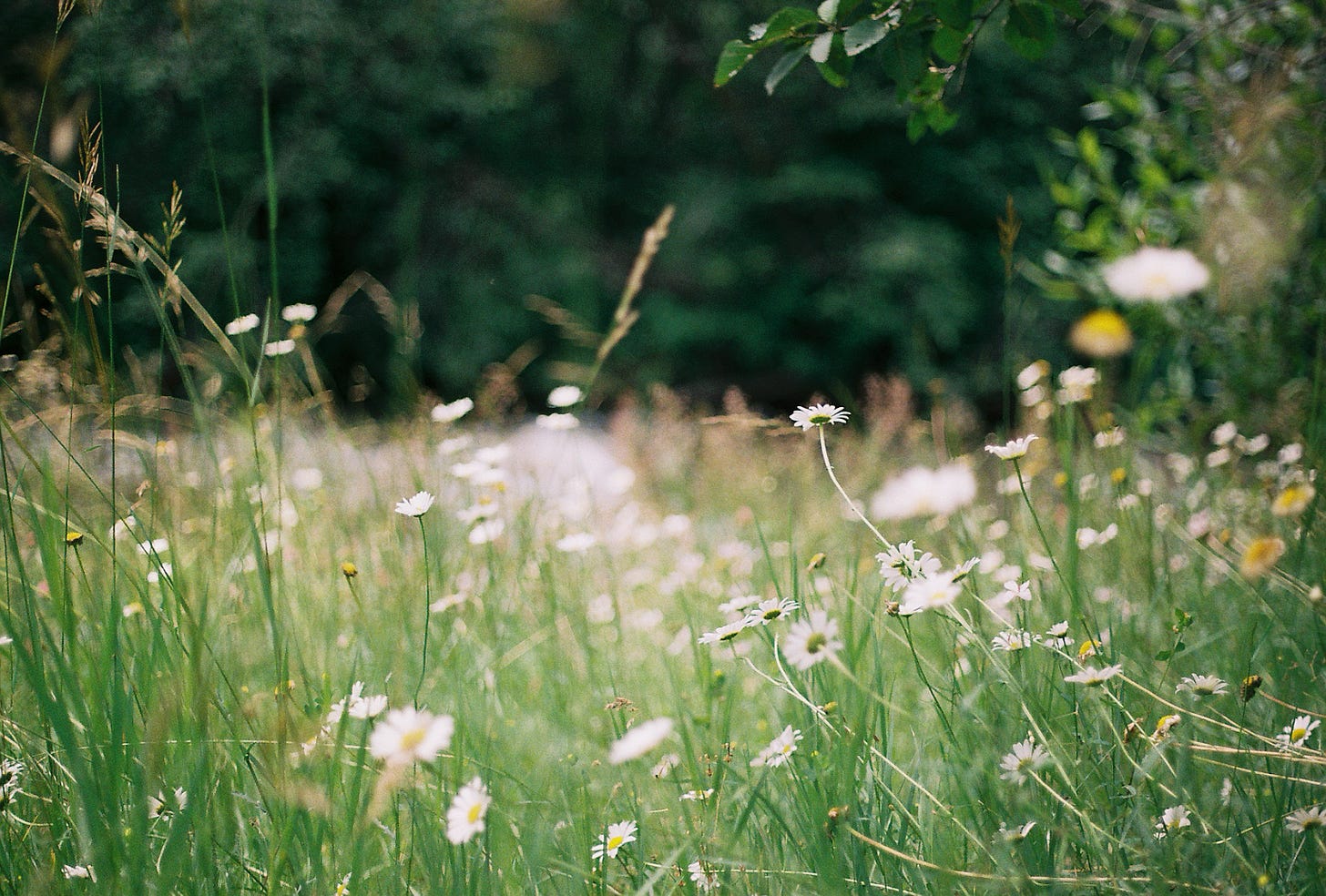10 Steps to Finding Joy During the Apocalypse
A guest post by Reina Lewis, MOT, OTR/L
Welcome to Healing is My Special Interest, the newsletter at the intersection of late-diagnosed neurodivergence and healing from high control environments. We are now at the stage of fascism where one must be careful what they post these days — but I am beyond proud to publish this timely guest post by Reina Lewis. In times like these, it is never a bad idea to go back to the basics of how to be in your body and squeeze out what joy you can in your day to day life. Things continue to look bleak in many areas, but hope (and resistance) is all around as well. Much love to everyone in the thick of it, and thank you to everyone who makes this newsletter possible.
10 Steps to Finding Joy During the Apocalypse
by Reina Lewis, MOT, OTR/L
Apocalypse
Originating from the Greek word “apokalypsis”
Meaning ‘unveiling’
- Uncovering what was once hidden -
Joy
Originating from the Latin word “gaudia”
Meaning ‘gladness,’ and ‘delight,’
- Pleasure & rejoicing -
Our world as we’ve known it has changed. (Or, the truths of this world are just being revealed?) We are living through the horrors, witnessing tragedies over and over on our ever-present screens, and we are still expected to do our silly little daily tasks and get our asses to work.
Every one of us deserves a medal, but there is no recognition for what each one of us is pushing through. Only you know how hard you are working.
We must celebrate ourselves.
For those of us who are neurodivergent, who are more likely to have C-PTSD, high pattern recognition, and strong senses of justice – celebrating & experiencing joy may feel like the antithesis to what we feel we should be doing during this time.
“Why should I enjoy things when there is SO MUCH suffering?”
Pause — take a deep breath as you look into this photo. See what stands out to you.
A photo of wildflowers in the Pecos wilderness, taken by me.
The question becomes even more complex for those of us who were indoctrinated within evangelical Christianity, which taught us to live in fear – of our bodies, of our desires, and of those unlike us. And, for those of us who have deconstructed from authoritarian religion, it can be difficult to live through this time without the comforting certainty that religion provided many of us. Hopelessness is a perfectly reasonable emotion for us to feel. However, it’s not helpful. Hopelessness is detrimental for our nervous systems, communities, and for the revolution we all hope for.
One of the most important parts of my deconstruction journey has been developing hope. I don’t think it could have been achieved without building my interoception — the capacity to identify, feel, and respond appropriately to my body’s internal cues. My work as an Occupational Therapist in various settings (outpatient mental health, inpatient children’s psych, and now in a skilled nursing facility) has provided me the opportunity to build this capacity within the clients and patients I treat.
The title of this post may seem too good to be true. The truth is that there are no easy 10 step solutions to feeling good when it feels like everything around us is on fire. My aim is not to give easy solutions, but to provide practical, evidence-based strategies that we can implement to build our capacity for joy, hope, and forward thinking. Take what you will, and leave what doesn’t serve you at this moment.
Another deep breath, the deepest breath you’ve taken all day. Notice what you notice, and one sensation in your body.
Shell Beach, CA. Taken by me.
All right. Here we go — 10 strategies for building our capacity for joy when we are completely out of control of the world that requires so much of us. (Not as catchy as the title I went with, right?)
Move
I know, I know. I’m sure this is annoying. But movement is so helpful and important. I’m specifically thinking about movement before, during, or after ingesting the insanity that is the news cycle. It should be movement that is achievable, and ideally movement that feeds your soul. Can you walk while you listen to your news podcast? Bounce on a yoga ball while you doom scroll? Shake it out when you see a few TikToks that rock your entire world? Can you incorporate a 1-3 song dance party for you and your kids when they get out of school? Having a hard time getting out of bed? Choose an animal and imagine how they’d move while horizontal — wiggle like a worm, stretch like a cat, squirm around on your back like a bug. *Any* movement is good movement, and brings us back to our bodies and the present moment.
Go outside
Sunlight is everything! Changing our environment can help our headspace! Noticing what we are drawn to, whether that be flowers, clouds, or street art can be life-giving.
Express gratitude
There is a lot of research to suggest that gratitude practices can help to change our neural pathways to notice the positive. This helps us to be mindful and present. It is a practice. These human animal brains are good at noticing everything that is wrong. Do what works for you and feels good, whether that be a list in your notes app, a daily photo of something you are grateful for, a junk journal page incorporating things you loved that month, or verbalizing out loud something you are grateful for with and without your loved ones present.
Address your burnout
One of my favorite resources comes from Dr. Megan Anna Neff from Neurodivergent Insights (find on Substack or insta) — Dr. Neff has this post with amazing visuals. For many neurodivergent people, visuals are beneficial— make it a lock screen or physically write on a piece of paper and put it in a place where you can see everyday to remind you of your plan when burnt out.
Pinpoint your sensory preferences
I love this tip a lot, and I think it is integral to understanding ourselves & coming back to our bodies as neurodivergent humans. Think about each sense — taste, touch, smell, hearing, sight, and vestibular. (There are actually more but that’s for another post). Think about your favorite things to experience within each sense. Make a physical or mental list, or a box full of all of your favorite sensory soothers. Think back to what you enjoyed as a kiddo— did you love to spin, click a pen, bite your erasers, or rub a soft blanket on your face? Find replacements for these things and consider doing them often, especially when feeling down.
Identify your values
As D.L shared in this post, “…the best indicator of whether or not a person resisted the Nazi party was their level of connection to their true self.” Part of this is identifying our values. One of my favorite resources for this is the Motivational Interviewing Values Card Sort. You can print and cut out the cards to physically sort, or there is this online resource that you can do to grapple with what matters to you. Identify the top ten, order based on level of importance to you, and — once again — make a visual that is accessible to you to remember who you are and what’s important to you. This helps us to not only know ourselves better, but also helps us to narrow down how we’d like to take part in building the world we want.
Engage with your special interests
Specifically, the ones that bring joy, gratitude, hope, and light. Remember the things throughout your life that made time disappear. Let your brain notice & follow the patterns of topics that lift up rather than tear down your soul.
Boost self-compassion
Another resource from another Dr. Neff! Dr. Kristen Neff has wonderful books and resources on her website to support building self-compassion, which she describes as: “we give ourselves the same kindness and support we’d give a good friend.” Obviously we don’t become proficient at this overnight. But imagine the world we could have if we all spoke to ourselves in a kind way??? You deserve it.
Build self-efficacy
This one is much more broad than the rest. All of the tips discussed can help us to build our self-efficacy — the belief that oneself has the ability to succeed. We need this if we want to contribute to our little worlds in the best way we can.
Breathe
Diaphragmatic breathing is the most accessible tool we have for calming our nervous systems. Just a couple of techniques for you—
4-7-8 breathing. Inhale for 4 seconds, hold for 7 (or however long you are able), and slooowly exhale through pursed lips for 8 seconds. Exhaling longer than inhaling communicates to the body that we are safe.
Progressive muscle relaxation. This combines movement & breath, another way to signify to the body that we are safe. With this, we are progressively tensing and relaxing our muscles with paired breathing. I like to do this while I lay down, starting with my feet. Inhale, squeeze your toes while you hold your breath, and exhale as you fully relax. Then calves. Inhale, hold and tense, exhale and relax. Go up through each muscle group. On the last one, squeeze every single muscle in your body, including your face, belly, hands, shoulders. Fully fully relax.
I hope this post gave you a couple of things to incorporate. I’m wishing everyone in this community radical gentleness & joy turned back toward yourselves. Thanks for reading :)
“Our essential task in life is to awaken to the way that the eternal would speak through us, to learn to live out our intended personality and the inner weirdness that makes us a unique torchbearer of the flame of life.” - Michael Meade (found in Neuroqueer Heresies by Nick Walker)
Reina is a traveling occupational therapist, creative, foodie, neurodivergent sensitive soul from Albuquerque, New Mexico. She has worked in various settings as a OT such as mental health, inpatient rehab, transitional housing, school-based, and skilled nursing facilities, promoting wellness in people of all ages. She strives to promote neurodivergent affirming care, self-compassion, and self-efficacy in her clients.





re: movement -- I know this can be a triggering one for folks but I have really been getting into micro movements? Is that a thing? Basically at night finding ways to wiggle and jiggle and flutter my hands (it all kinda feels like stimming) or doing some Tai Chi exercises. I also got a vibration plate a few months ago and it has been a lifesaver for me. It is very low energy/effort, but when I am on it for ten minutes I do a lot of stretching and let out like 10-20 yawns. It truly feels like anxiety/stress is being shaken out of my muscles.
What an essential and excellent post. Thank you Reina!!